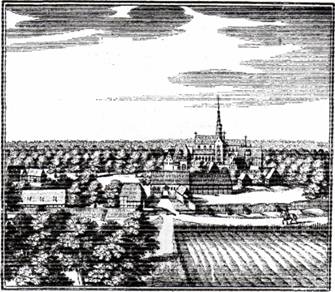Short Information in English

- Reproduction of a copperplate engraving by Matthäus Merian – 1654
The Cistercian Lutheran Protestant Abbey of Amelungsborn
The Amelungsborn monastery was founded in the heyday of the Cistercian Order in 1135 by monks of the Rhineland abbey of Altencamp. According to the statues of the order new monastic settlements were required to be in remote places far from other settlements to enforce the monastic ideal of asceticism in combination with hard manual labour. Amelungsborn and the related Cistercian abbey of Loccum (founded in 1163) are the only two evangelic monasteries in Germany with an uninterrupted tradition. Amelungsborn was the source of a number of monasteries that contributed to the Spiritual and economic development in the Northeast of Germany like Doberan in Mecklenburg. In 1280 there were 50 monks and 90 lay brothers in Amelungsborn, a comparatively large number indicating the importance of this monastery. In 1568 Abbot and Convent followed their sovereign the Duke of Brunswick in accepting Luther's new creed.
Reduced in number they took care of the adjoining parishes and opened a Latin boarding-school preparing boys for theological studies at the State University of Helmstedt. The monastic tradition of religious Services was maintained until the school was transferred to the nearby town of Holzminden.
In the course of time the monastic buildings deteriorated increasingly, and in the 19th Century important parts, such as the cloister, even suffered demolition. In 1655 the Abbot of Amelungsborn was also appointed head of the Holzminden diocese of the Duchy of Brunswick, of which Amelungsborn was part. Under the rule of Napoleon in 1806 the Amelungsborn Convent was discharged leaving only the position of the Abbot untouched. From 1912 to 1960 this Position was vacant for political reasons.
In the last days of World War II the abbey was badly ruined, but soon rebuilt for ecclesiastical use as parish church for the neighbouring villages Golmbach, Holenberg, Lüt-genade, Negenborn, Reileifzen and Warbsen, and to house seminars and conferences.
With Christhard Mahrenholz being appointed 54th abbot in 1960, the revival of monastic life was made possible. A convent consisting of 7 clerical members and a Jurist, and a brotherhood (familiaritas) were called. They meet regularly throughout the year. Activities include four daily prayers, study of the Bible, discussions of religious and social topics, as well as hours of silence, personal exchange and manual labour.
On the occasion of their inauguration the Amelungsborn brothers commit themselves
- to consider a word of the Bible daily
- to give thanks to God and ask for guidance through the day
- to practice the befitted Christian intercession on behalf of themselves, as well for Church and World
- to be available with their professional qualifications to the church itself as well as clerical and non-clerical groups meeting in the monastery.
Since 2002 the Right Reverend Eckhard Gorka has been 58th abbot of Amelungsborn.
The Abbey church is open daily throughout the year from 8 a.m. to 7 p.m. Sunday Services are held from April through November at 10 a.m.
HWG 15.3.07
